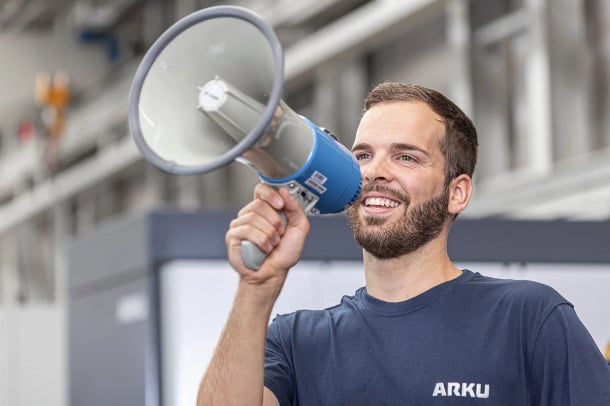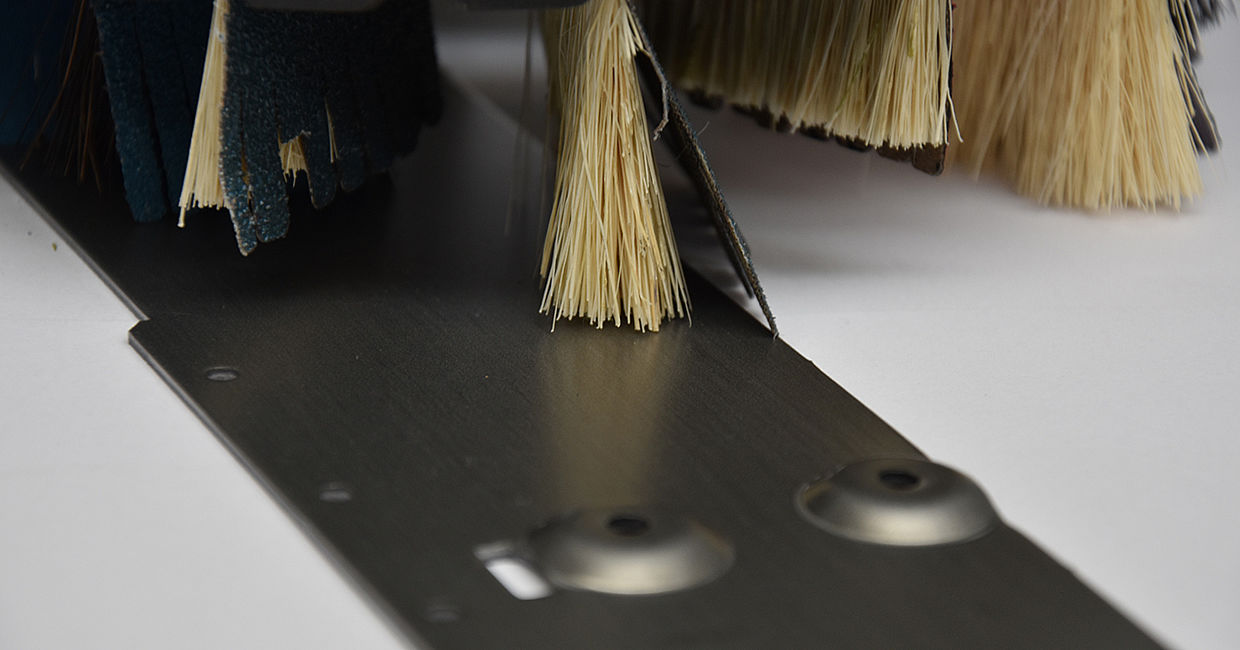
ARKU Newsletter
Exciting events, informative case studies, practical expert tips: With the ARKU Newsletter you are always well informed.

Anyone who wants to use a deburring machines quickly asks themselves the same question. Whether the materials should be processed single or double-sided. In this article we will show you the differences between the processes and the corresponding advantages.
This is particularly fast with deburring machines that work double-sided. Allowing the parts to be processed from the top and bottom side in just a single pass. Therefore saving more than 50% of the time compared to a single-sided deburring machine. This doesn’t only take into account that parts have to be ran twice, but also in terms of handling the workpieces. The double-sided machine thus saves between 40 and 80 Euros per hour. Indicating that even with just a few hours of usage per week, it can pay off big time. So for economic reasons, the decision is “always double-sided”!
Even if only one side of the sheet metal parts are to be processed, a double-sided deburring machine can still be useful. This may eliminate the need for presorting or flipping the workpieces over. This can be a time-consuming and dangerous task with larger workpieces or heavy flame-cut parts. If – depending on the manufacturing processes – you add investments for additional handling equipment to compensate for a single-sided deburring machine, the expected price advantage can quickly turn into the opposite.
But there are also useful applications for single-sided deburring machines. In contrast to double-sided machines, single-sided ones often have a vacuum table as a support. This allows you to securely fix and process even smaller parts that would otherwise “fall through the cracks” if they were to be processed from both sides simultaneously. This makes a single-sided machine interesting for laser job shops for example, since they deal with a large array of different parts.
A supported surface for sheet metal parts by a vacuum table also allows certain rounding processes, for a machine equipped with rotary brushes. The edge rounding process with rotary brushes achieves the best possible rounding results on inner and outer contours, since the brushes make contact with the material from different directions. The processing result is very uniform, regardless of the shape and orientation of the parts. Even a radius of up to 2.0 mm can be achieved with the rotary rounding brushes.
In addition to deburring and edge rounding, machines processing from only one side also allow for a surface finish as a final step. To achieve such, the machines are equipped with a separate unit for surface processing.
In summary, it is mainly technical reasons that make the single-sided machines interesting for some applications. This is the case for not only small parts, but also large and wide sheet metal parts. Laser or plasma-cut parts that require a particularly strong or even rounding are also part of the processing spectrum. With the possible selection of various processing units for deburring, rotary brush edge rounding and surface finishing, a single-sided machine can be used flexibly for a wide range of processing tasks.
So when deciding on a deburring machine that processes either single or double-sided, it becomes clear what is most important: the range of parts and the processes during production. With a single-sided machine, you can cover a greater variety of workpieces and achieve more uniform edge rounding. However in return, you have to calculate for more time and possible increase in material handling costs. With a double-sided deburring machine, on the other hand, you gain in efficiency but are less flexible when it comes to the variety of parts you can process.
When making your decision, you do not have to decide irrevocably on what your future range of parts should be. If a deburring machine can cover 80% of your production materials, that is already a satisfactory and most importantly, realistic goal. To handle special one off cases, contract deburring is still an alternative.
One last final tip: in certain situations it is worthwhile to calculate whether it would be better to purchase two deburring machines – one being double-sided for the efficiency of processing a large quantity of workpieces. The single-sided machine would then be for the processing of small parts. As a user, you have thus combined the best of both worlds for your production.
From an economic point of view, you should always choose a double-sided machine. From just a few hours a week, the processing of your parts in just a single pass will pay off. Like the EdgeBreaker® 3000, the most efficient machine for processing laser-cut parts. Avoid the flipping of heavy flame and plasma-cut parts and relay on the double-sided processing capability of the EdgeBreaker® 4000. But if you want to be prepared for vast array of events, take a look at the EdgeBreaker® 6000. This is the most universal deburring machine in the ARKU EdgeBreaker® lineup.

Exciting events, informative case studies, practical expert tips: With the ARKU Newsletter you are always well informed.
ARKU Maschinenbau GmbH
Siemensstraße 11
76532 Baden-Baden / Germany
T: +49 7221 5009-0
F: +49 7221 5009-11
Machines in use at customers, practical tips, events and much more: keep up with the news in the ARKU world.
ARKU Maschinenbau GmbH © 2023 Mail info@arku.com Tel. +49 180 555 27 58